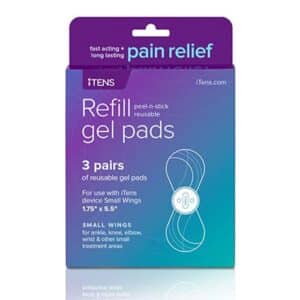
A stimulator for back pain can deliver immediate relief with the potential to improve the quality of life for those with chronic conditions. It is a portable device that uses low-voltage electrical currents to activate natural mechanisms in the body. It works by overriding the sensory nerves to block pain signals and release endorphins. This can provide numerous benefits, such as a drug-free method of pain relief. It is portable and easy to use at home.
Back pain is a common issue that can greatly impact daily activities. A person may miss work, school, or important events because of debilitating symptoms. Therefore, effective pain management is vital to prevent it from affecting everyday routines. One of the convenient and cost-effective solutions is an electrical stimulation device. This article will explore the components of a back pain stimulator, how it works, and the benefits of using one.
What is a Stimulator for Back Pain?
A stimulator for back pain is a device that sends electrical pulses to alleviate discomfort and unpleasant sensations. There are different types of devices. One is the spinal cord stimulator, which is implanted within the epidural space or near the buttocks. It has a pulse generator and leads. In addition, it is suitable for those with chronic pain conditions.
Another type is the Transcutaneous Electrical Nerve Stimulation (TENS) machine. It is a battery-operated device with adhesive electrode pads placed on the pain area to deliver the electrical pulses. In contrast to a spinal cord stimulator, TENS is an external, non-invasive device. Individuals use the device whenever they need relief and remove it after the treatment.
These devices are adjustable units to control the electrical stimulation. Users can modify the intensity and frequency of the currents based on their comfort level. Moreover, it utilises leads to transmit the pulses from the device to the body. However, some modern TENS machines have wireless capacity. They use Bluetooth connectivity to control the treatment from a smartphone.
Causes of Backaches
- Poor posture while sitting or standing.
- Muscle strain or tension from heavy lifting, sudden movements, or overuse.
- Bulging or ruptured discs in the spine that can irritate the nerve endings.
- Arthritis, facet joint dysfunction or other joint conditions.
- Obesity or excess weight putting pressure on the spine.
- Injuries and trauma from accidents, falls or playing sports.
- Osteoporosis that weakens the bones in the spine.
- Skeletal irregularities like scoliosis or lordosis.
- Failed Back Surgery Syndrome (FBSS), a lumbar pain that persists after a spinal surgery.
- Complex Regional Pain Syndrome (CRPS), a chronic condition affecting the limbs and lower back. It often follows a fracture or amputation.

How a Stimulator for Back Pain Works
A stimulator for back pain works by targeting the source of the pain. The device delivers small electrical currents from the electrodes to the body. This process targets the nerves, causing them to block pain signals. In particular, it closes the “neural gates” in the spinal cord, hindering the pain signals from reaching the brain.
Another method of relieving pain is stimulating the release of endorphins. These natural chemicals bind to peripheral nerves, inhibiting them from sending pain messages. As a result, the body experiences significant pain reduction. Endorphins also help reduce anxiety and stress that may contribute to back pain. Additionally, the electric current can improve blood circulation, reducing inflammation and speeding up the healing process of injured or damaged tissues.
In spinal cord stimulation, a trial period will determine if the device is effective for the individual. During this trial, a temporary stimulator is placed near the spinal cord to assess its impact on pain relief. If successful, a health provider will proceed with permanent implantation.
Frequencies and Intensities
Frequency is the rate or number of pulses per second. It ranges from low (1-10 Hz) to high (50-130 Hz) current stimulation. Low-frequency stimulation produces mild tingling sensations which are pleasant and relaxing. Conversely, high-frequency therapy creates strong but comfortable sensations. It is ideal for acute or severe pain like post-surgical procedure.
On the other hand, intensity refers to the strength of the electrical signals. The stimulator settings allow the adjustment of intensity to cater to various pain levels. As such, different combinations of frequency and intensity can produce several therapeutic effects. Therefore, trying various settings or modes can help find optimal relief.

Benefits of Using a Stimulator for Back Pain
One of the benefits of a stimulator for back pain is its natural or non-drug approach. It can provide effective relief without side effects or other adverse risks of strong medications. Thus, many use it as an alternative to regular medicine intake. In addition, it can provide long-lasting effects. Individuals can use it long-term without the risk of developing dependence.
Another benefit is targeted pain relief. Spinal cord stimulation devices target the source of pain. By directly stimulating the nerves in the back, it can provide localised relief and increase the range of motion. It minimises the need for oral medication and the potential systemic negative effects. Furthermore, TENS and the implantable pulse generator have adjustable settings. This flexibility allows for personalised pain management.
Lastly, the device can be incorporated with physical therapy methods. Using TENS or a spinal cord stimulator does not interfere with chiropractic care, exercises, or spinal manipulation. Combining different strategies can enhance the overall pain relief and rehabilitation process. The stimulator can complement other treatments, making it a versatile tool for managing back pain.
Is It Safe and Effective?
Using a stimulator device is generally safe and effective. They are easy to use with controlled settings to prevent adverse risks. Nevertheless, it is essential to consult with a pain specialist to get appropriate treatment or medical advice. For example, they can guide on the correct placement of electrodes or stimulator settings.
In some cases, a primary care provider can advise against electrical stimulation for individual patients with severe medical conditions. Moreover, some patients may experience redness at the site of the skin incision or electrode placement. However, they quickly disappear. In terms of effectiveness, clinical studies show improvement in pain symptoms with regular use.
Conclusion
A stimulator for back pain can be a valuable tool in managing various conditions. The device works by sending small electric currents to stimulate the nerves, thereby blocking pain signals and releasing endorphins. As a result, a person can experience a substantial reduction in pain. Additionally, it offers many benefits, such as drug-free pain relief and shortened pain duration. Aside from back pain, it can help manage leg pain, neck pain, and neuropathic pain affecting other areas.
Before using the device or starting any treatment, it is vital to consult with a pain specialist. They can help determine the appropriate pain management method and proper usage guidelines for the device. These procedures can minimise the need for pain medications, nerve blocks, or epidural corticosteroids. In conclusion, it can help alleviate pain and enhance the effectiveness of rehabilitative therapy. It can help improve the quality of life in patients with chronic pain conditions.





















